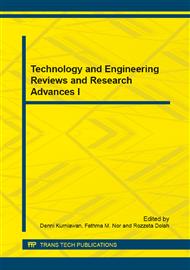[1]
M. Fadaeenejad, A.M. Saberian, Mohd. Fadaee, M.A.M. Radzi, H. Hizam and M.Z.A. AbKadir, The present and future of smart power grid in developing countries, Renewable and Sustainable Energy Reviews, Volume 29, January 2014, p.828–834.
DOI: 10.1016/j.rser.2013.08.072
Google Scholar
[2]
Amy Poh Ai Ling, Sugihara Kokichi, Mukaidono Masao, A Review: Japan's Smart Grid Practice, Journal of Pervasive Technology, Vol. 1, No. 1, December, 2011, pp.15-22.
Google Scholar
[3]
Amy Poh Ai Ling, Japan and US Smart Grid Effort? A case study, Malaysia-Japan Academic Scholar Conference, Nov. 2013, Tokyo, Japan, p.18.
DOI: 10.1007/978-4-431-54439-5_33
Google Scholar
[4]
Estimating the Costs and Benefits of the Smart Grid-A Preliminary Estimate of the Investment Requirements and the Resultant Benefits of a Fully Functioning Smart Grid, Electric Power Research Institute (EPRI), 2011 Technical Report.
Google Scholar
[5]
Takeshi Haita, Development of Maximum Demand Prediction Support System Based on Multiple Regression, Japan Operations Research Institute, 41(9), pp.476-480, (1996).
Google Scholar
[6]
M. Beccali, M. Cellura, etc, Forecasting daily urban electric load profiles using artificial neural networks, Energy Conversiion and Management, 45, pp.2879-2900, (2004).
DOI: 10.1016/j.enconman.2004.01.006
Google Scholar
[7]
S. Fan, L. Chen, Short-Term Load Forecasting Based on an Adaptive Hybrid Method, IEEE Transactions on Power Systems, 21(1), (2006).
DOI: 10.1109/tpwrs.2005.860944
Google Scholar
[8]
James W. Taylor, A comparison of univariate methods for forecasting electricity demand up to a day ahead, International Journal of Forecasting 22 (2006), p.1 – 16.
DOI: 10.1016/j.ijforecast.2005.06.006
Google Scholar
[9]
JungsukKwac, June Flora, and Ram Rajagopal, Household Energy Consumption Lifestyle Segmentation Using Hourly Data, IEEE Transactions on Smart Grid, accepted for publication.
DOI: 10.1109/tsg.2013.2278477
Google Scholar
[10]
TEPCO past demand database: http: /www. tepco. co. jp/forecast/html/download-j. html.
Google Scholar
[11]
Amy Poh Ai Ling, Tan Chin Woo, EvgenyMozgunov, Electric Power Consumption, Simplifying the Data, Malaysia-Japan Academic Scholar Conference 2013, #25, p.75, November 2013, Tokyo, Japan.
Google Scholar
[12]
V. Figueiredo, F. Rodrigues, Z. Vale and J. B Gouveia , An Electric Energy Consumer Characterization Framework Based on Data Mining Techniques, Power Systems, IEEE Trans, vol. 20, pp.596-602, May (2005).
DOI: 10.1109/tpwrs.2005.846234
Google Scholar
[13]
G. W Irwin, W. Monteith, and W. C. Beattie, Statistical electricity demand modelling from consumer billing data, Generation, Transmission and Distribution, IEE Proceedings C, vol. 133, pp.328-335, (1986).
DOI: 10.1049/ip-c.1986.0048
Google Scholar
[14]
M. Espinoza, C. Joye, R. Belmans and B. DeMoor, Short-TermLoad Forecasting, Profile Identification, and Customer Segmentation: AMethodology Based on Periodic Time Series, Power Systems, IEEE Trans, vol. 20, pp.1622-1630, Aug (2005).
DOI: 10.1109/tpwrs.2005.852123
Google Scholar


